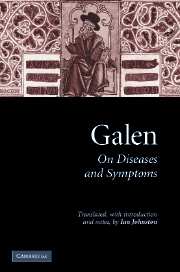Book contents
- Frontmatter
- Contents
- List of tables
- Acknowledgements
- List of abbreviations
- PART I INTRODUCTION
- PART II TRANSLATION
- II.0 Introduction
- II.1 On the Differentiae of Diseases
- II.2 On the Causes of Diseases
- II.3 On the Differentiae of Symptoms
- II.4 On the Causes of Symptoms I
- II.5 On the Causes of Symptoms II
- II.6 On the Causes of Symptoms III
- PART III CONCLUSION
- Bibliography
- Index
II.2 - On the Causes of Diseases
Published online by Cambridge University Press: 22 September 2009
- Frontmatter
- Contents
- List of tables
- Acknowledgements
- List of abbreviations
- PART I INTRODUCTION
- PART II TRANSLATION
- II.0 Introduction
- II.1 On the Differentiae of Diseases
- II.2 On the Causes of Diseases
- II.3 On the Differentiae of Symptoms
- II.4 On the Causes of Symptoms I
- II.5 On the Causes of Symptoms II
- II.6 On the Causes of Symptoms III
- PART III CONCLUSION
- Bibliography
- Index
Summary
SYNOPSIS
I.1 A statement of aim – having catalogued and classified all diseases, to identify the causes of each. For simple (homoiomeric) parts, on the ‘first hypothesis’ (that of anarmoi/poroi) all diseases are either (i) a disproportion of pores, or (ii) a dissolution of continuity. On the ‘second hypothesis’ (that of elements and qualities) there are four ‘simple’ dyscrasias and four ‘combined’ dyscrasias.
II.1 Listing of 5 causes of excessive heat: (i) movement; (ii) putrefaction; (iii) proximity to another hot body; (iv) constriction; (v) food with the ‘necessary capability’. Examples are given in each case, using inanimate objects.
II.2 How excess heat comes about from these five causes.
II.3 A consideration of why a putative cause does not invariably produce the same effect. The explanation lies in variations in the magnitude and duration of the cause and in the state of the affected body. Again, inanimate examples are given.
II.4 Further consideration on the variability of the relationship between presumed cause and expected effect.
II.5 A distinction is drawn between proegoumenic and prokatarktic causes. The former are either ‘conditions pertaining to the animal itself or abnormal movements’ (internal antecedent causes) whilst the latter are external factors (external antecedent causes).
III.1 Enumeration of six causes of excess cold: (i) contact with cold things; (ii) certain foods and drinks; (iii) constriction; (iv) rarefaction; (v) idleness; (vi) disproportionate movement.
III.2 As in II.2, an elaboration of how these causes produce abnormal cold, again illustrated with inanimate examples.
III.3 Examples of causes of contact with external cold and their observed effects clinically.[…]
- Type
- Chapter
- Information
- Galen: On Diseases and Symptoms , pp. 157 - 179Publisher: Cambridge University PressPrint publication year: 2006



